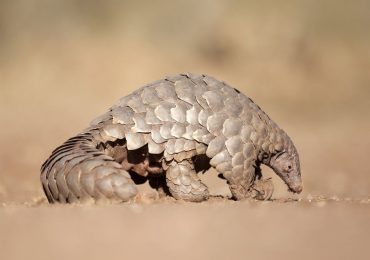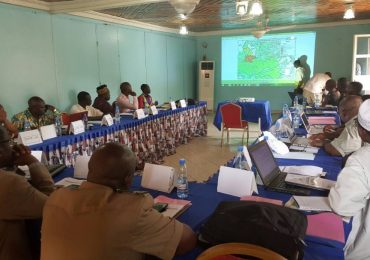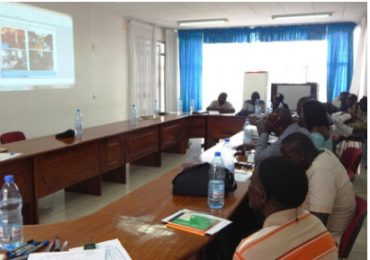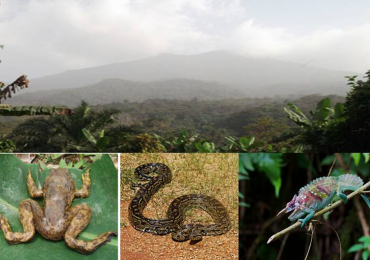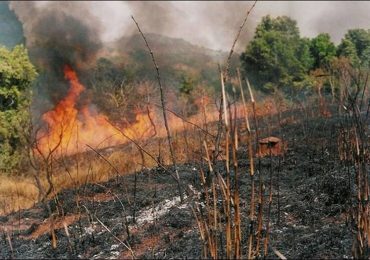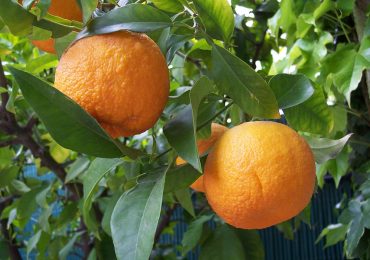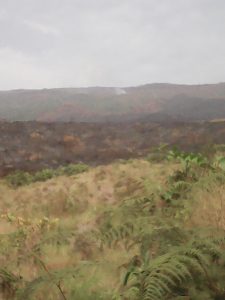
Mount Cameroon is undoubtedly the highest mountain in West and Central Africa, and one of the rarest ecosystems in the world. It starts from a zero metre altitude at sea level with unique unbroken vegetation gradient from evergreen lowland rainforest through sub montane and montane forest to alpine grassland near its summit at about 4100 m above sea level.
It is one of the country’s protected areas providing safe havens to Cameroon’s depleting primates, small and large mammals, reptiles, birds and aquatic fauna.
Created by a Prime Ministerial Decree in 2009, recent surveys indicate that the 58.178 hectares national park plays host to some ten large mammals including over 260 African elephant (Loxodonta cyclotis), who strive up to an altitude of over 2700 meters above sea level. It is also house to over 300 chimpanzees (Pan troglodytes); unknown population of red river hog (Potamochoerus porcus); bushbuck (Tragelaphus scriptus); bay duiker (Cephalophus dorsalis); blue duiker (Cephalophus monticola); yellow-backed duiker (Cephalophus sylvicultor) and others.
The area is also home to small mammals including 22 species of bats and some strict endemic species like the Eisentraut’s Shrew (Crocidura eisentrauti), Arrogant Shrew (Sylvisorex morio) and Mount Cameroon Brush-furred Rat (Lophuromys roseveari); another near-endemic is the Cameroon Praomys (Praomys morio).
As far as birds are concerned, the Mount Cameroon National Park serves as a safe haven to over 250 birds species. Out of these, research shows that eight are threatened including the Mount Cameroon Francolin (Francolinus camerunensis), the Black capped Speirops (Speirops lugubris) and the Mount Cameroon Rough-Wing Swallow (Psalidoprocne spp). All these birds are unique to the Mt Cameroon Region. The Cameroon Blue-headed Sunbird (Nectarinia oritis) is endemic while the Grey-necked Picathartes (Picathartes oreas) is rare. Research shows that most of the birds in this area, are territorial, that is they can be seen in and out of season.
Insects also take refuge within this biodiversity hot spot. Information from the Park Service indicates that there are over 203 unidentified butterfly species in this ecosystem three of which are endemic to this site. Meanwhile, at least one spider species is known to exist in the Mount Cameroon National Park.
Also, Mount Cameroon is known for its exceptional plant diversity and high number of endemic species. Studies show that there are not less than 5000 plant species within the Mount Cameroon Area. Out of these, at least 100 are endemic to Mt Cameroon; 46 endangered with several studies underway to determine the taxonomy; name, altitude, uses and degree of endemism following the IUCN classification.
There are equally enormous varieties of Non-timber forest products that serve as food, fuel, medicine and provide other household items to the adjacent communities. Some of these include Prunus africana, mushrooms, palm wine, cola nut, monkey Kola, bitter cola, bush plum, eru, country onion, alligator pepper, bush pepper, and njangsang amongst others.
Besides the plant species, they are over 86 reptile species, representing more than one third of the reptile fauna known in the Mount Cameroon Area making it among the richest in the country. The area also has endemic amphibian species like the endemic toad (Werneria preussi) and near-endemics four-digit toad (Didynamipus sjostedti), Tandy’s small tongue toad (Werneria tandyi) and a frog (Arthroleptis bivittatus). Meanwhile, a total of 35 fish species have as well been recorded within this protected area.
The uniqueness of this biodiversity hotspot has over the years, transformed the area into one of the few touristic destinations of Cameroon with several ecotourists visiting the protected area on a yearly basis.
Statistics from the Mount Cameroon Park Service indicates that over 553 registered tourists from diversed origin visited the site from 2012 to 2013. This number increased to over 700 from 2013 to 2014. From 2014 to 2015, it rose again to 1,000 ecotourists. This number almost doubled from 2015 to 2016 with over 1,857 tourists recorded. As of February 7, 2017, information from the Park Services confirmed 80 registered ecotourists already went to the Mountain.
International Tourists seeking access into the park, per the Finance law, are to pay 5000 FRS as entry fee; while foreigners with resident permits and Cameroonians pay 3000 and1500frs respectively. Fifty five percent (55%) of this fees goes into the state treasury, while 45% is deposited at the special funds for wildlife at BICEC.
The Mount Cameroon National Park it should be noted, cuts across 41 villages each of which has about three to five inlets with a 130km boundary. This has m
ade the effective restriction of illegal visits into the park really problematic to the Park Service especially with limited eco-guards. However, increasing collaboration from community members via sensitization has over the years reduced encroachment from 300 hectares a few years ago to less than 20 hectares into the park.
By Bertrand Shancho Ndimuh


